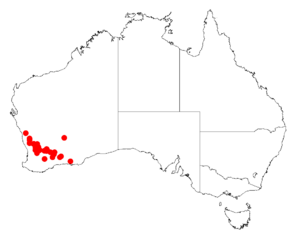Acacia spinosissima facts for kids
Quick facts for kids Acacia spinosissima |
|
|---|---|
| Scientific classification | |
| Genus: |
Acacia
|
| Species: |
spinosissima
|
 |
|
| Occurrence data from AVH | |
Acacia spinosissima is a type of shrub that belongs to the Acacia plant family. It is found naturally in the southwestern part of Australia.
What Does Acacia spinosissima Look Like?
This shrub can be spreading or grow in a compact, tangled shape. It usually reaches a height of about 0.2 to 1.5 meters (0.7 to 5 feet) tall. Its branches have lines and ridges, and they are often covered with a thin, white, powdery layer. Many short, spiny branches spread out from the main ones. These spiny parts often don't have leaves.
Like most Acacia plants, it has phyllodes instead of true leaves. Phyllodes are flattened leaf stalks that act like leaves. The phyllodes of Acacia spinosissima grow upwards or straight. They are narrow and oblong, usually straight or slightly S-shaped. These green phyllodes are typically 3 to 8 millimeters long and 1 to 2 millimeters wide. They have a faint, slightly raised line down the middle, but no side veins.
This plant blooms from August to September. It produces bright yellow flowers. The flowers grow in small groups called inflorescences. These groups are found alone on very short stems, less than 0.5 millimeters long. Each flower group is round, like a ball, about 3 to 3.5 millimeters across. They contain 7 to 23 bright lemon-yellow flowers.
After the flowers, thin, leathery seed pods form. These pods are rounded over the seeds. They can grow up to 6 centimeters long and 3 to 5 millimeters wide. The pods are also covered in a fine, white, powdery coating. Inside the pods, the seeds are dark brown and oblong. Each seed is about 2.5 millimeters long.
Where Does This Plant Grow?
Acacia spinosissima is native to the Wheatbelt region of Western Australia. It commonly grows on gently rolling plains. You can often find it in sandy soils mixed with gravel. These soils are sometimes found over or around a type of reddish soil called laterite. It can also grow in loamy or clay soils.
Its natural range stretches from around Cadoux in the north. It goes south to places like Brookton. To the east, it can be found as far as Lake King.

